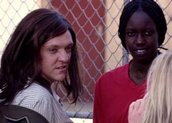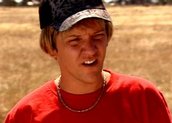


We Can Be Heroes – Episode 3 (2005)
Synopsis
Mockumentary series We Can Be Heroes follows five very different nominees for the Australian of the Year award in the lead-up to the event. In this episode, former policeman bravery award recipient and wannabe motivational speaker Phil Olivetti secures his first speaking engagement. Schoolgirl Ja’mie King discovers one of her World Vision sponsor children has escaped Sudan and is staying in Villawood detention centre. Twins Daniel and Nathan Sims count the days until their world-first eardrum transplant operation. Housewife turned elite athlete Pat Mullins continues training for her world record roll to Uluru. Gifted physics student Ricky Wong starts rehearsals for his lead role in Indidgeridoo: The Musical with the university’s Chinese theatre group.
All six characters are played by Chris Lilley.
Curator’s notes
Update from the curator (12 June 2020):
These notes, written in 2008, do not adequately address issues of representation in this series, including the use of yellowface in the portrayal of the character Ricky Wong. The curator recommends further reading on histories of yellowface, for example Kat Chow’s Round Table: The Past and Present of ‘Yellowface’ (2014) and Jenn Fang’s Yellowface, Whitewashing and the history of White People Playing Asian Characters (2018); and further reading on Asian Australian representation on screen, for example Tseen Khoo’s Where are the Asians on Australian Screens? (2018) and Carolyn Cage’s Time for nuanced Asian representation (2020).
Original Curator’s Notes:
To describe Chris Lilley’s comedy is to talk paradoxes. It’s exaggerated but believable; absurd but touching. His characters tap into stereotypes but are also unique. The central paradox is the step we take as an audience in believing his portrayal of such vastly different characters: on one level we laugh at this central comic device; on another our suspension of disbelief makes the rest of the comedy possible. While laughing and cringing at Ricky Wong’s portrayal of an Aboriginal Elder in Indidgeridoo: The Musical, for instance, we believe Lilley as Wong.
The believability of Lilley’s characters stems not only from his performances but from the world built up around them through location, production design and costumes and the documentary approach taken to capturing it. The details are played for realism and carefully faithful to each milieu depicted. The excellent supporting cast are also very important. A combination of actors and non-actors, selected for their authenticity in the roles and ability to work with Lilley’s improvisational style, deliver natural, low-key performances. Pat is made all the more believable by Mick Graham’s endearing performance as her husband and coach; Ja’mie by her gang of teenage friends. Their deadpan acceptance of Lilley as family member or peer invites our acceptance also.
As with many great comic creations, Lilley’s characters lack any awareness of being funny. Despite the absurdity of Pat’s planned roll to Uluru, for instance, she is utterly sincere about it; as is Ricky with his performance and Daniel with his ideas of how the ear transplant will change his family’s life. Their sincerity places us at times in the position of both laughing and sympathising, with some moments that tug at the heartstrings. On the flipside we have Ja’mie and Phil – characters who lack awareness of how grotesquely unpleasant they are. In either case, the joke lies in the deadpan presentation of seemingly real situations where certain elements are pushed to absurd extremes.
The way this invites us to reflect on these scenarios is interesting. Pat’s rigorous training regime and history of overcoming adversity are absurd in the context of long-distance rolling – but if we replaced rolling with swimming or walking they’d be common features of a type of serious story well-loved in current affairs media.
In this episode, Ja’mie brazenly uses Sonali’s plight for her own self-promotion and Ricky rehearses his performance as an Aboriginal man with a blissful lack of awareness of how problematic it is. Both demonstrate Lilley’s knack for highlighting cultural and social sensitivities by using characters that trample them, while himself crossing cultural and social lines with his performances. However, it’s interesting to compare how the different characters’ actions come across. While Ja’mie’s are comically repugnant, Ricky’s are comically misguided and somehow endearing. Ultimately it seems to boil down to the distinctive personality each character has and the motives Lilley gives them for behaving in the way they do. While Lilley draws on stereotypes, he also makes his characters unique. Ja’mie’s teenage girl jargon or Ricky’s struggle between duty and creativity are culturally familiar, but Ja’mie’s vanity and Ricky’s exuberance seem to belong to these particular individuals.
- Overview
- Curator’s notes
- Video 3 clips
- Principal credits
- Find a copy
- Make a comment
- Map
- Add your review



